A Review of Equivalent Circuit Model Based Online State of Power Estimation for Lithium-Ion Batteries in Electric Vehicles
Abstract
:1. Introduction
2. Online SOP Estimation
2.1. SOP Estimation at a Constant Current Mode
2.2. SOP Estimation at a Constant Voltage Mode
2.3. SOP Estimation at a Constant Current Constant Voltage Mode
- The OLPMs at CC and CV modes keep a battery operating within a safe voltage range by reducing either peak average current or peak instantaneous current in a prediction window, which are more straightforward than the OLPM at a CCCV mode. It is worth noting that the OLPMs at the CC and CV modes are essentially the same when the length of the prediction window L is taken as one.
- The OLPM at a CV mode does not take current limit into account. This may cause an over-optimistic SOP estimation at high (or low) SOC regions during the discharge (or charge) process. To involve current limit, the OLPM at a CCCV mode is developed.
- The OLPM at a CC mode provides a relatively conservative, yet stable, peak current estimation, which is of benefit to the development of a long-term (>30 s) driving strategy for EVs. By contrast, OLPMs at CV and CCCV modes are more suitable for a short term (<10 s) driving strategy for EVs. However, they may provide an over-aggressive driving strategy by ideally assuming a constant OCV in a lengthy prediction window, while making the best use of battery voltage range to supply as much power as possible at every instant. In consequence, EVs may acquire a strong power supply in a short period but fall into energy poverty very soon, since the battery OCV would gradually decline, and the real peak current is going to drop more rapidly than expected after a battery being shifted to a CV mode.
- The OLPMs at CV and CCCV modes may risk batteries in overcharging and over-discharging, since they require fairly accurate knowledge about SOC and battery model in real-time to perfectly hold a battery at voltage limit throughout a prediction window.
3. Improvements on ECM-Based Method for Online SOP Estimation
3.1. Improvements on Battery Modelling
3.1.1. Improved 1-RC Model
3.1.2. Other Models
3.2. Improved Online Parameter Identification Technique
3.3. Improvements on SOP Estimation Methods
3.3.1. Long-Term SOP Estimation
3.3.2. Optimisation Control-Based SOP Estimation
3.3.3. SOP-Related Multi-State Co-Estimation
3.3.4. Machine Learning-Based SOP Estimation
3.3.5. Pack-Level SOP Estimation
4. SOP Testing Methods
4.1. Hybrid Pulse Power Characterization Test
- The HPPC test is improper for examining SOP estimation in a relatively long prediction window (>30 s), since battery OCV variation in a pulse is neglected.
- The HPPC test cannot be performed for dynamic SOP validation, since it must start from a static condition.
- Equation (2) cannot accurately reproduce battery end-of-pulse internal resistance at the real peak currents. This is because battery polarisation voltage indicates a strong nonlinear correlation with the current amplitude, while the real peak currents will be much greater than the applied current in the HPPC test. As a result, the calibrated will lead to a significant deviation in SOP reference from the HPPC test.
- The HPPC test can only validate SOP estimation under voltage limit.
4.2. Hybrid Pulse Test
- Step one. Discharge a battery from a fully charged state to 80% SOC, followed by one-hour relaxation.
- Step two. Discharge a battery at a conservative guess of peak discharge current for 10 s, and ensure the end-of-pulse voltage will not breach the voltage limit. Record the released capacity and battery terminal voltage at the end of 10 s.
- Step three. Charge back the released capacity to the battery and remain the battery at the same initial SOC, namely 80% SOC, followed by another one-hour relaxation.
- Step four. Gradually increase the current amplitude and repeat steps two and three five more times. Plot the attempted currents versus the corresponding battery terminal voltages at the end of 10 s. Fit them using a straight line, as shown in Figure 19b.
- Step five. Extrapolate the peak discharge current by extending the fitted line to the lower cut-off voltages.
- It requires battery end-of-pulse voltage to be close enough to the upper (of lower) cut-off voltage for an accurate extrapolation, since an approximate linear relationship between the attempted current and battery end-of-pulse voltage only appears in a limited range.
- It requires the discharged capacity in the last pulse test to be charged back to the battery for keeping the same initial SOC before applying the next pulse. However, there will always exist a slight difference in initial OCVs and, thus, SOCs, due to battery hysteresis effect, which may affect the accuracy of the calibrated SOP references.
4.3. Constant Voltage Constant Power Test
4.4. Constant Current Test
- Step one. Fully charge a battery and then discharge the battery to 80% SOC, followed by one-hour relaxation.
- Step two. Discharge the battery at the estimated peak discharge current until the battery terminal voltage reaches the lower cut-off voltage. Record the testing time t1.
- Step three. Repeat steps one and two four more times at different current amplitudes. Make sure the testing time is approaching the length of a prediction window, namely 10 s.
- Step four. Fit the correlation between the attempted current and recorded testing times as a nonlinear curve. Reference value of the peak discharge current corresponds to , as shown in Figure 21.
- Different current attempts may not be evenly distributed, which may affect curve fitting.
- Nonlinear fitting of the recorded data is likely to run into overfitting or underfitting with only five pairs of measurements.
- Referring to Peukert’s law, battery testing time is not proportional to current in a CC discharge profile.
4.5. Constant Voltage Discharge Test
- Step one. Fully charge a battery and then discharge the battery to 80% SOC, followed by one-hour relaxation.
- Step two. Discharge the battery using a rapid increasing pulse, of which the current amplitude will jump to a large value within a very short period (e.g., 0.1 s). Therefore, three cases would happen in a prediction window, as shown in Figure 22.
- Step three. Battery peak power at the end of a pulse can be directly calculated as the product of the current limit and voltage at the end of pulse or the product of the voltage limit and current at the end of pulse.
5. Challenges and Outlooks
5.1. Equivalent-Circuit Model
5.2. Parameter Identification Techniques
5.3. Battery Multi-State Co-Estimation
5.4. Machine Learning
5.5. Validation Approach
6. Conclusions
Author Contributions
Funding
Conflicts of Interest
Nomenclature
| AFFLS | Adaptive forgetting factor least square |
| AFFRTLS | Adaptive forgetting factor recursive total least square |
| ANFIS | Adaptive neuro-fuzzy inference system |
| BMS | Battery management system |
| BVE | Butler–Volmer equation |
| CC | Constant current |
| CCCV | Constant current constant voltage |
| CM | Characteristic mapping |
| CP | Constant power |
| CV | Constant voltage |
| CVCP | Constant voltage constant power |
| DAEKF | Dual adaptive extended Kalman filter |
| DEKF | Dual extended Kalman filter |
| DMC | Dynamic matrix control |
| DP | Dual polarisation |
| ECM | Equivalent circuit model |
| EIS | Electrochemical impedance spectroscopy |
| EKF | Extended Kalman filter |
| ELM | Extreme learning machine |
| EV | Electrical vehicle |
| FFRLS | Forgetting factor recursive least square |
| GA | Genetic algorithm |
| HPPC | Hybrid pulse power characterization |
| KF | Kalman filter |
| MHE | Moving horizon estimation |
| MMPI | Multistep model predictive iterative |
| MPC | Model predictive control |
| OCV | Open-circuit voltage |
| OLPM | Open-loop prediction method |
| PSO | Particle swarm optimisation |
| RLS | Recursive least square |
| SOC | State of charge |
| SOE | State of energy |
| SOH | State of health |
| SOP | State of power |
| SOT | State of temperature |
| UKF | Unscented Kalman filter |
| VLERO | Voltage limited with extrapolation of resistances and open-circuit voltage |
| WRLS | Weighted recursive least square |
References
- Tran, M.-K.; Akinsanya, M.; Panchal, S.; Fraser, R.; Fowler, M. Design of a Hybrid Electric Vehicle Powertrain for Performance Optimization Considering Various Powertrain Components and Configurations. Vehicles 2021, 3, 20–32. [Google Scholar] [CrossRef]
- Hu, X.; Zou, C.; Zhang, C.; Li, Y. Technological Developments in Batteries: A Survey of Principal Roles, Types, and Management Needs. IEEE Power Energy Mag. 2017, 15, 20–31. [Google Scholar] [CrossRef]
- Scrosati, B.; Garche, J. Lithium Batteries: Status, Prospects and Future. J. Power Sources 2010, 12, 2419–2430. [Google Scholar] [CrossRef]
- Varga, B.O. Electric Vehicles, Primary Energy Sources and CO2 Emissions: Romanian Case Study. Energy 2013, 49, 61–70. [Google Scholar] [CrossRef]
- Han, W.; Altaf, F.; Zou, C.; Wik, T. State of Power Prediction for Battery Systems with Parallel-Connected Units. IEEE Trans. Transp. Electrif. 2021, 1. [Google Scholar] [CrossRef]
- Van Reeven, V.; Hofman, T. Multi-Level Energy Management for Hybrid Electric Vehicles—Part, I. Vehicles 2019, 1, 3–40. [Google Scholar] [CrossRef] [Green Version]
- Van Reeven, V.; Hofman, T. Multi-Level Energy Management—Part II: Implementation and Validation. Vehicles 2019, 1, 41–56. [Google Scholar] [CrossRef] [Green Version]
- Hu, X.; Jiang, H.; Feng, F.; Liu, B. An Enhanced Multi-State Estimation Hierarchy for Advanced Lithium-Ion Battery Management. Appl. Energy 2020, 257, 114019. [Google Scholar] [CrossRef]
- Farmann, A.; Sauer, D.U. A Comprehensive Review of On-Board State-of-Available-Power Prediction Techniques for Lithium-Ion Batteries in Electric Vehicles. J. Power Sources 2016, 329, 123–137. [Google Scholar] [CrossRef]
- Plett, G.L. High-Performance Battery-Pack Power Estimation Using a Dynamic Cell Model. IEEE Trans. Veh. Technol. 2004, 53, 1586–1593. [Google Scholar] [CrossRef] [Green Version]
- Sun, F.; Xiong, R.; He, H.; Li, W.; Aussems, J.E.E. Model-Based Dynamic Multi-Parameter Method for Peak Power Estimation of Lithium–Ion Batteries. Appl. Energy 2012, 96, 378–386. [Google Scholar] [CrossRef]
- Sun, F.; Xiong, R.; He, H. Estimation of State-of-Charge and State-of-Power Capability of Lithium-Ion Battery Considering Varying Health Conditions. J. Power Sources 2014, 259, 166–176. [Google Scholar] [CrossRef]
- Wang, S.; Verbrugge, M.; Wang, J.S.; Liu, P. Multi-Parameter Battery State Estimator Based on the Adaptive and Direct Solution of the Governing Differential Equations. J. Power Sources 2011, 196, 8735–8741. [Google Scholar] [CrossRef]
- Pei, L.; Zhu, C.; Wang, T.; Lu, R.; Chan, C.C. Online Peak Power Prediction Based on a Parameter and State Estimator for Lithium-Ion Batteries in Electric Vehicles. Energy 2014, 66, 766–778. [Google Scholar] [CrossRef]
- Zhang, H.; Chow, M.-Y. Comprehensive Dynamic Battery Modeling for PHEV Applications. In Proceedings of the IEEE PES General Meeting, IEEE, Minneapolis, MN, USA, 25–29 August 2010; pp. 1–6. [Google Scholar]
- Hu, X.; Li, S.; Peng, H. A Comparative Study of Equivalent Circuit Models for Li-Ion Batteries. J. Power Sources 2012, 198, 359–367. [Google Scholar] [CrossRef]
- Lai, X.; Zheng, Y.; Sun, T. A Comparative Study of Different Equivalent Circuit Models for Estimating State-of-Charge of Lithium-Ion Batteries. Electrochim. Acta 2018, 259, 566–577. [Google Scholar] [CrossRef]
- Wang, X.; Wei, X.; Zhu, J.; Dai, H.; Zheng, Y.; Xu, X.; Chen, Q. A Review of Modeling, Acquisition, and Application of Lithium-Ion Battery Impedance for Onboard Battery Management. eTransportation 2021, 7, 100093. [Google Scholar] [CrossRef]
- Wang, S.; Verbrugge, M.; Wang, J.S.; Liu, P. Power Prediction from a Battery State Estimator That Incorporates Diffusion Resistance. J. Power Sources 2012, 214, 399–406. [Google Scholar] [CrossRef]
- Hu, X.; Xiong, R.; Egardt, B. Model-Based Dynamic Power Assessment of Lithium-Ion Batteries Considering Different Operating Conditions. IEEE Trans. Ind. Inf. 2014, 10, 1948–1959. [Google Scholar] [CrossRef]
- Wang, Y.; Pan, R.; Liu, C.; Chen, Z.; Ling, Q. Power Capability Evaluation for Lithium Iron Phosphate Batteries Based on Multi-Parameter Constraints Estimation. J. Power Sources 2018, 374, 12–23. [Google Scholar] [CrossRef]
- Wei, C.; Benosman, M. Extremum Seeking-Based Parameter Identification for State-of-Power Prediction of Lithium-Ion Batteries. In Proceedings of the 2016 IEEE International Conference on Renewable Energy Research and Applications (ICRERA), IEEE, Birmingham, UK, 20–23 November 2016; pp. 67–72. [Google Scholar]
- Xiang, S.; Hu, G.; Huang, R.; Guo, F.; Zhou, P. Lithium-Ion Battery Online Rapid State-of-Power Estimation under Multiple Constraints. Energies 2018, 11, 283. [Google Scholar] [CrossRef] [Green Version]
- Dong, G.; Wei, J.; Chen, Z. Kalman Filter for Onboard State of Charge Estimation and Peak Power Capability Analysis of Lithium-Ion Batteries. J. Power Sources 2016, 328, 615–626. [Google Scholar] [CrossRef]
- Feng, T.; Yang, L.; Zhao, X.; Zhang, H.; Qiang, J. Online Identification of Lithium-Ion Battery Parameters Based on an Improved Equivalent-Circuit Model and Its Implementation on Battery State-of-Power Prediction. J. Power Sources 2015, 281, 192–203. [Google Scholar] [CrossRef]
- Jiang, J.; Liu, S.; Ma, Z.; Wang, L.Y.; Wu, K. Butler-Volmer Equation-Based Model and Its Implementation on State of Power Prediction of High-Power Lithium Titanate Batteries Considering Temperature Effects. Energy 2016, 117, 58–72. [Google Scholar] [CrossRef]
- Waag, W.; Fleischer, C.; Sauer, D.U. Adaptive On-Line Prediction of the Available Power of Lithium-Ion Batteries. J. Power Sources 2013, 242, 548–559. [Google Scholar] [CrossRef]
- Tang, X.; Wang, Y.; Yao, K.; He, Z.; Gao, F. Model Migration Based Battery Power Capability Evaluation Considering Uncertainties of Temperature and Aging. J. Power Sources 2019, 440, 227141. [Google Scholar] [CrossRef]
- Yang, L.; Cai, Y.; Yang, Y.; Deng, Z. Supervisory Long-Term Prediction of State of Available Power for Lithium-Ion Batteries in Electric Vehicles. Appl. Energy 2020, 257, 114006. [Google Scholar] [CrossRef]
- Burgos-Mellado, C.; Orchard, M.E.; Kazerani, M.; Cárdenas, R.; Sáez, D. Particle-Filtering-Based Estimation of Maximum Available Power State in Lithium-Ion Batteries. Appl. Energy 2016, 161, 349–363. [Google Scholar] [CrossRef]
- Zheng, F.; Jiang, J.; Sun, B.; Zhang, W.; Pecht, M. Temperature Dependent Power Capability Estimation of Lithium-Ion Batteries for Hybrid Electric Vehicles. Energy 2016, 113, 64–75. [Google Scholar] [CrossRef]
- Zheng, L.; Zhu, J.; Wang, G.; Lu, D.D.-C.; McLean, P.; He, T. Experimental Analysis and Modeling of Temperature Dependence of Lithium-Ion Battery Direct Current Resistance for Power Capability Prediction. In Proceedings of the 2017 20th International Conference on Electrical Machines and Systems (ICEMS), IEEE, Sydney, Australia, 11–14 August 2017; pp. 1–4. [Google Scholar]
- Wang, Y. Online Estimation of Battery Power State Based on Improved Equivalent Circuit Model. IOP Conf. Ser. Earth Environ. Sci. 2021, 651, 022080. [Google Scholar] [CrossRef]
- Zou, C.; Klintberg, A.; Wei, Z.; Fridholm, B.; Wik, T.; Egardt, B. Power Capability Prediction for Lithium-Ion Batteries Using Economic Nonlinear Model Predictive Control. J. Power Sources 2018, 396, 580–589. [Google Scholar] [CrossRef]
- Tan, Y.; Luo, M.; She, L.; Cui, X. Joint Estimation of Ternary Lithium-Ion Battery State of Charge and State of Power Based on Dual Polarization Model. Int. J. Electrochem. Sci. 2020, 15, 20. [Google Scholar] [CrossRef]
- Shen, P.; Ouyang, M.; Lu, L.; Li, J.; Feng, X. The Co-Estimation of State of Charge, State of Health, and State of Function for Lithium-Ion Batteries in Electric Vehicles. IEEE Trans. Veh. Technol. 2017, 67, 92–103. [Google Scholar] [CrossRef]
- Nejad, S.; Gladwin, D.T. Online Battery State of Power Prediction Using PRBS and Extended Kalman Filter. IEEE Trans. Ind. Electron. 2020, 67, 3747–3755. [Google Scholar] [CrossRef]
- Niri, M.F.; Dinh, T.Q.; Yu, T.F.; Marco, J.; Bui, T.M.N. State of Power Prediction for Lithium-Ion Batteries in Electric Vehicles via Wavelet-Markov Load Analysis. IEEE Trans. Intell. Transp. Syst. 2020, 1–16. [Google Scholar] [CrossRef]
- Shu, X.; Li, G.; Shen, J.; Lei, Z.; Chen, Z.; Liu, Y. An Adaptive Multi-State Estimation Algorithm for Lithium-Ion Batteries Incorporating Temperature Compensation. Energy 2020, 207, 118262. [Google Scholar] [CrossRef]
- Dubarry, M.; Liaw, B.Y. Development of a Universal Modeling Tool for Rechargeable Lithium Batteries. J. Power Sources 2007, 174, 856–860. [Google Scholar] [CrossRef]
- Li, X.; Sun, J.; Hu, Z.; Lu, R.; Zhu, C.; Wu, G. A New Method of State of Peak Power Capability Prediction for Li-Ion Battery. In Proceedings of the 2015 IEEE Vehicle Power and Propulsion Conference (VPPC), IEEE, Montreal, QC, Canada, 19–22 October 2015; pp. 1–5. [Google Scholar]
- Podlubny, I. Fractional Differential Equations: An. Introduction to Fractional Derivatives, Fractional Differential Equations, to Methods of Their Solution and Some of Their Applications; Elsevier: Amsterdam, The Netherlands, 1998. [Google Scholar]
- Liu, C.; Hu, M.; Jin, G.; Xu, Y.; Zhai, J. State of Power Estimation of Lithium-Ion Battery Based on Fractional-Order Equivalent Circuit Model. J. Energy Storage 2021, 41, 102954. [Google Scholar] [CrossRef]
- Farmann, A.; Sauer, D.U. Comparative Study of Reduced Order Equivalent Circuit Models for On-Board State-of-Available-Power Prediction of Lithium-Ion Batteries in Electric Vehicles. Appl. Energy 2018, 225, 1102–1122. [Google Scholar] [CrossRef]
- Lai, X. Co-Estimation of State of Charge and State of Power for Lithium-Ion Batteries Based on Fractional Variable-Order Model. J. Clean. Prod. 2020, 255, 120203. [Google Scholar] [CrossRef]
- Gao, W.; Zou, Y.; Sun, F.; Hu, X.; Yu, Y.; Feng, S. Data Pieces-Based Parameter Identification for Lithium-Ion Battery. J. Power Sources 2016, 328, 174–184. [Google Scholar] [CrossRef]
- Jiang, B.; Dai, H.; Wei, X.; Zhu, L.; Sun, Z. Online Reliable Peak Charge/Discharge Power Estimation of Series-Connected Lithium-Ion Battery Packs. Energies 2017, 10, 390. [Google Scholar] [CrossRef] [Green Version]
- Xiong, R.; He, H.; Sun, F.; Liu, X.; Liu, Z. Model-Based State of Charge and Peak Power Capability Joint Estimation of Lithium-Ion Battery in Plug-in Hybrid Electric Vehicles. J. Power Sources 2013, 229, 159–169. [Google Scholar] [CrossRef]
- Xiong, R.; He, H.; Sun, F.; Zhao, K. Online Estimation of Peak Power Capability of Li-Ion Batteries in Electric Vehicles by a Hardware-in-Loop Approach. Energies 2012, 5, 1455–1469. [Google Scholar] [CrossRef]
- Xiong, R.; Sun, F.; Chen, Z.; He, H. A data-driven multi-scale extended Kalman filtering based parameter and state estimation approach of lithium-ion polymer battery in electric vehicles. Appl. Energy 2014, 113, 463–476. [Google Scholar] [CrossRef]
- Li, B.; Wang, S.; Fernandez, C.; Yu, C.; Xia, L.; Fan, Y. A Linear Recursive State of Power Estimation Method Based on Fusion Model of Voltage and State of Charge Limitations. J. Energy Storage 2021, 40, 102583. [Google Scholar] [CrossRef]
- Wei, Z.; Zhao, J.; Xiong, R.; Dong, G.; Pou, J.; Tseng, K.J. Online Estimation of Power Capacity With Noise Effect Attenuation for Lithium-Ion Battery. IEEE Trans. Ind. Electron. 2019, 66, 5724–5735. [Google Scholar] [CrossRef]
- Plett, G.L. Dual and Joint EKF for Simultaneous SOC and SOH Estimation. In Proceedings of the 21st Electric Vehicle Symposium (EVS21), Monte Carlo, Monaco, 2–6 April 2005; pp. 1–12. [Google Scholar]
- Juang, L.W.; Kollmeyer, P.J.; Jahns, T.M.; Lorenz, R.D. Implementation of Online Battery State-of-Power and State-of-Function Estimation in Electric Vehicle Applications. In Proceedings of the 2012 IEEE Energy Conversion Congress and Exposition (ECCE), IEEE, Raleigh, NC, USA, 15–20 September 2012; pp. 1819–1826. [Google Scholar]
- Zhang, W.; Wang, L.; Wang, L.; Liao, C.; Zhang, Y. Joint State-of-Charge and State-of-Available-Power Estimation Based on the Online Parameter Identification of Lithium-Ion Battery Model. IEEE Trans. Ind. Electron. 2021, 1. [Google Scholar] [CrossRef]
- Zhou, Z.; Kang, Y.; Shang, Y.; Cui, N.; Zhang, C.; Duan, B. Peak Power Prediction for Series-Connected LiNCM Battery Pack Based on Representative Cells. J. Clean. Prod. 2019, 230, 1061–1073. [Google Scholar] [CrossRef]
- Waag, W.; Fleischer, C.; Sauer, D.U. On-Line Estimation of Lithium-Ion Battery Impedance Parameters Using a Novel Varied-Parameters Approach. J. Power Sources 2013, 237, 260–269. [Google Scholar] [CrossRef]
- Zhang, X.; Wang, Y.; Wu, J.; Chen, Z. A Novel Method for Lithium-Ion Battery State of Energy and State of Power Estimation Based on Multi-Time-Scale Filter. Appl. Energy 2018, 216, 442–451. [Google Scholar] [CrossRef]
- Chen, Z.; Lu, J.; Yang, Y.; Xiong, R. Online Estimation of State of Power for Lithium-Ion Battery Considering the Battery Aging. In Proceedings of the 2017 Chinese Automation Congress (CAC), IEEE, Jinan, China, 20–22 October 2017; pp. 3112–3116. [Google Scholar]
- Lu, J.; Chen, Z.; Yang, Y.; Ming, L.V. Online Estimation of State of Power for Lithium-Ion Batteries in Electric Vehicles Using Genetic Algorithm. IEEE Access 2018, 6, 20868–20880. [Google Scholar] [CrossRef]
- Malysz, P.; Ye, J.; Gu, R.; Yang, H.; Emadi, A. Battery State-of-Power Peak Current Calculation and Verification Using an Asymmetric Parameter Equivalent Circuit Model. IEEE Trans. Veh. Technol. 2016, 65, 11. [Google Scholar] [CrossRef]
- Wang, L.; Cheng, Y.; Zou, J. Battery Available Power Prediction of Hybrid Electric Vehicle Based on Improved Dynamic Matrix Control Algorithms. J. Power Sources 2014, 261, 337–347. [Google Scholar] [CrossRef]
- Esfandyari, M.J.; Hairi Yazdi, M.R.; Esfahanian, V.; Masih-Tehrani, M.; Nehzati, H.; Shekoofa, O. A Hybrid Model Predictive and Fuzzy Logic Based Control Method for State of Power Estimation of Series-Connected Lithium-Ion Batteries in HEVs. J. Energy Storage 2019, 24, 100758. [Google Scholar] [CrossRef]
- Esfandyari, M.J.; Esfahanian, V.; Hairi Yazdi, M.R.; Nehzati, H.; Shekoofa, O. A New Approach to Consider the Influence of Aging State on Lithium-Ion Battery State of Power Estimation for Hybrid Electric Vehicle. Energy 2019, 176, 505–520. [Google Scholar] [CrossRef]
- Zhang, W.; Shi, W.; Ma, Z. Adaptive Unscented Kalman Filter Based State of Energy and Power Capability Estimation Approach for Lithium-Ion Battery. J. Power Sources 2015, 289, 50–62. [Google Scholar] [CrossRef]
- Zhang, T.; Guo, N.; Sun, X.; Fan, J.; Yang, N.; Song, J.; Zou, Y. A Systematic Framework for State of Charge, State of Health and State of Power Co-Estimation of Lithium-Ion Battery in Electric Vehicles. Sustainability 2021, 13, 5166. [Google Scholar] [CrossRef]
- Rahimifard, S.; Ahmed, R.; Habibi, S. Interacting Multiple Model Strategy for Electric Vehicle Batteries State of Charge/Health/ Power Estimation. IEEE Access 2021, 9, 109875–109888. [Google Scholar] [CrossRef]
- Fleischer, C.; Waag, W.; Bai, Z.; Sauer, D.U. Self-Learning State-of-Available-Power Prediction for Lithium-Ion Batteries in Electrical Vehicles. In Proceedings of the 2012 IEEE Vehicle Power and Propulsion Conference, Seoul, South Korea, 9–12 October 2012; pp. 370–375. [Google Scholar]
- Tang, X.; Yao, K.; Liu, B.; Hu, W.; Gao, F. Long-Term Battery Voltage, Power, and Surface Temperature Prediction Using a Model-Based Extreme Learning Machine. Energies 2018, 11, 86. [Google Scholar] [CrossRef] [Green Version]
- Roşca, B.; Wilkins, S.; Jacob, J.; Hoedemaekers, E.; Van Den Hoek, S. Predictive Model Based Battery Constraints for Electric Motor Control within EV Powertrains. In Proceedings of the 2014 IEEE International Electric Vehicle Conference (IEVC), IEEE, Florence, Italy, 17–19 December 2014; pp. 1–8. [Google Scholar]
- Li, X.; Xu, J.; Hong, J.; Tian, J.; Tian, Y. State of Energy Estimation for a Series-Connected Lithium-Ion Battery Pack Based on an Adaptive Weighted Strategy. Energy 2021, 214, 118858. [Google Scholar] [CrossRef]
- Zhang, C.; Sharkh, S.M. Estimation of Real-Time Peak Power Capability of a Traction Battery Pack Used in an HEV. In Proceedings of the 2010 Asia-Pacific Power and Energy Engineering Conference, IEEE, Chengdu, China, 28–31 March 2010; pp. 1–6. [Google Scholar]
- Shen, X.; Sun, B.; Qi, H.; Shen, X.; Su, X. Research on Peak Power Test Method for Lithium Ion Battery. Energy Procedia 2018, 152, 550–555. [Google Scholar] [CrossRef]
- Jin, C.; Sun, Y.; Zheng, Y.; Yang, X.; Lai, X.; Gu, H.; Feng, X. Experimental Investigation of State-of-power Measurement for Lithium-ion Batteries. Int. J. Energy Res. 2021, 45, 7549–7560. [Google Scholar] [CrossRef]
- Hunt, G.; Motloch, C. Freedom Car Battery Test Manual for Power-Assist Hybrid Electric Vehicles; INEEL: Falls, ID, USA, 2003; pp. 3–6. [Google Scholar]
- Xiong, R.; Tian, J.; Shen, W.; Sun, F. A Novel Fractional Order Model for State of Charge Estimation in Lithium Ion Batteries. IEEE Trans. Veh. Technol. 2019, 68, 4130–4139. [Google Scholar] [CrossRef]
- Tian, J.; Xiong, R.; Yu, Q. Fractional-Order Model-Based Incremental Capacity Analysis for Degradation State Recognition of Lithium-Ion Batteries. IEEE Trans. Ind. Electron. 2018, 66, 1576–1584. [Google Scholar] [CrossRef]
- Ling, L.; Wei, Y. State-of-Charge and State-of-Health Estimation for Lithium-Ion Batteries Based on Dual Fractional-Order Extended Kalman Filter and Online Parameter Identification. IEEE Access 2021, 9, 47588–47602. [Google Scholar] [CrossRef]
- Lin, C.; Mu, H.; Xiong, R.; Shen, W. A Novel Multi-Model Probability Battery State of Charge Estimation Approach for Electric Vehicles Using H-Infinity Algorithm. Appl. Energy 2016, 166, 76–83. [Google Scholar] [CrossRef]
- Xiong, R.; Wang, J.; Shen, W.; Tian, J.; Mu, H. Co-Estimation of State of Charge and Capacity for Lithium-Ion Batteries with Multi-Stage Model Fusion Method. Engineering 2021, S2095809921000163. [Google Scholar] [CrossRef]
- Lao, Z.; Xia, B.; Wang, W.; Sun, W.; Lai, Y.; Wang, M. A Novel Method for Lithium-Ion Battery Online Parameter Identification Based on Variable Forgetting Factor Recursive Least Squares. Energies 2018, 11, 1358. [Google Scholar] [CrossRef] [Green Version]
- Tan, X.; Zhan, D.; Lyu, P.; Rao, J.; Fan, Y. Online State-of-Health Estimation of Lithium-Ion Battery Based on Dynamic Parameter Identification at Multi Timescale and Support Vector Regression. J. Power Sources 2021, 484, 229233. [Google Scholar] [CrossRef]
- Hua, X.; Zhang, C.; Offer, G. Finding a Better Fit for Lithium Ion Batteries: A Simple, Novel, Load Dependent, Modified Equivalent Circuit Model and Parameterization Method. J. Power Sources 2021, 484, 229117. [Google Scholar] [CrossRef]
- Zhang, J.; Wang, P.; Liu, Y.; Cheng, Z. Variable-Order Equivalent Circuit Modeling and State of Charge Estimation of Lithium-Ion Battery Based on Elec-trochemical Impedance Spectroscopy. Energies 2021, 14, 769. [Google Scholar] [CrossRef]
- Li, Z.; Shi, X.; Shi, M.; Wei, C.; Di, F.; Sun, H. Investigation on the Impact of the HPPC Profile on the Battery ECM Parameters’ Offline Identification. In Proceedings of the 2020 Asia Energy and Electrical Engineering Symposium (AEEES), IEEE, Chengdu, China, 29–31 May 2020; pp. 753–757. [Google Scholar]
- Song, Y.; Liu, D.; Liao, H.; Peng, Y. A Hybrid Statistical Data-Driven Method for on-Line Joint State Estimation of Lithium-Ion Batteries. Appl. Energy 2020, 261, 114408. [Google Scholar] [CrossRef]
- Hu, X.; Yuan, H.; Zou, C.; Li, Z.; Zhang, L. Co-Estimation of State of Charge and State of Health for Lithium-Ion Batteries Based on Fractional-Order Calculus. IEEE Trans. Veh. Technol. 2018, 67, 10319–10329. [Google Scholar] [CrossRef]
- Xiong, R.; Zhang, Y.; He, H.; Zhou, X.; Pecht, M.G. A Double-Scale, Particle-Filtering, Energy State Prediction Algorithm for Lithium-Ion Batteries. IEEE Trans. Ind. Electron. 2018, 65, 1526–1538. [Google Scholar] [CrossRef]
- Hu, X.; Feng, F.; Liu, K.; Zhang, L.; Xie, J.; Liu, B. State Estimation for Advanced Battery Management: Key Challenges and Future Trends. Renew. Sustain. Energy Rev. 2019, 114, 109334. [Google Scholar] [CrossRef]
- Lipu, M.H.; Hannan, M.; Hussain, A.; Saad, M.H.M.; Ayob, A.; Muttaqi, K.M. Lithium-Ion Battery State of Charge Estimation Method Using Optimized Deep Recurrent Neural Network Algorithm. In Proceedings of the 2019 IEEE Industry Applications Society Annual Meeting, IEEE, Baltimore, MD, USA, 29 September–3 October 2019; pp. 1–9. [Google Scholar]
- Hannan, M.A.; Lipu, M.H.; Hussain, A.; Ker, P.J.; Mahlia, T.; Mansor, M.; Ayob, A.; Saad, M.H.; Dong, Z. Toward Enhanced State of Charge Estimation of Lithium-Ion Batteries Using Optimized Machine Learning Techniques. Sci. Rep. 2020, 10, 1–15. [Google Scholar]
- Tian, J.; Xiong, R.; Shen, W.; Sun, F. Electrode Ageing Estimation and Open Circuit Voltage Reconstruction for Lithium Ion Batteries. Energy Storage Mater. 2021, 37, 283–295. [Google Scholar] [CrossRef]
- Hannan, M.A.; Lipu, M.S.H.; Hussain, A.; Mohamed, A. A Review of Lithium-Ion Battery State of Charge Estimation and Management System in Electric Vehicle Applications: Challenges and Recommendations. Renew. Sustain. Energy Rev. 2017, 78, 834–854. [Google Scholar] [CrossRef]
- Naaz, F.; Herle, A.; Channegowda, J.; Raj, A.; Lakshminarayanan, M. A Generative Adversarial Network-Based Synthetic Data Augmentation Technique for Battery Condition Evaluation. Int. J. Energy Res. 2021, 45, 19120–19135. [Google Scholar] [CrossRef]
- Jiao, R.; Peng, K.; Dong, J. Remaining Useful Life Prediction of Lithium-Ion Batteries Based on Conditional Variational Autoencoders-Particle Filter. IEEE Trans. Instrum. Meas. 2020, 69, 8831–8843. [Google Scholar] [CrossRef]
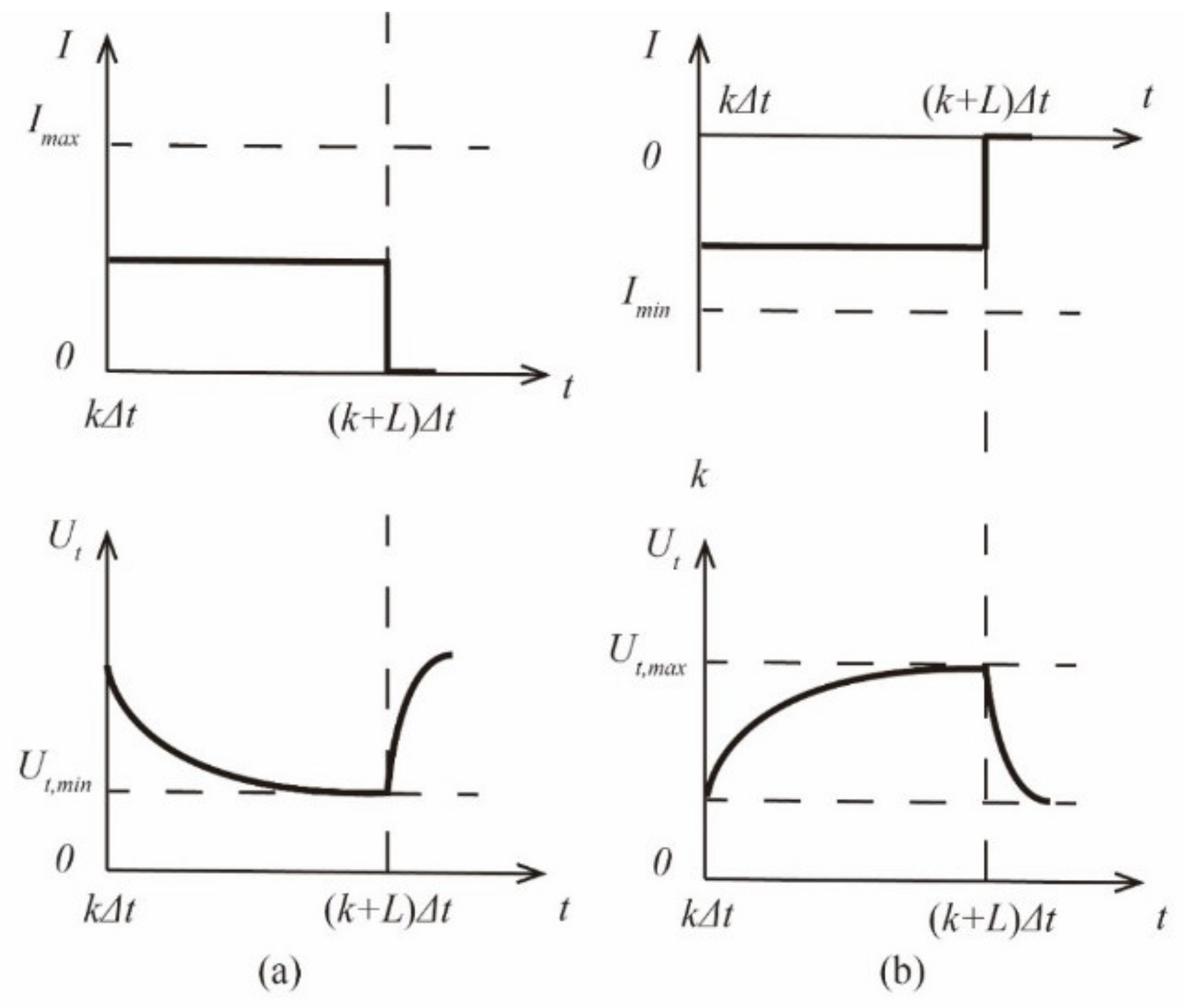
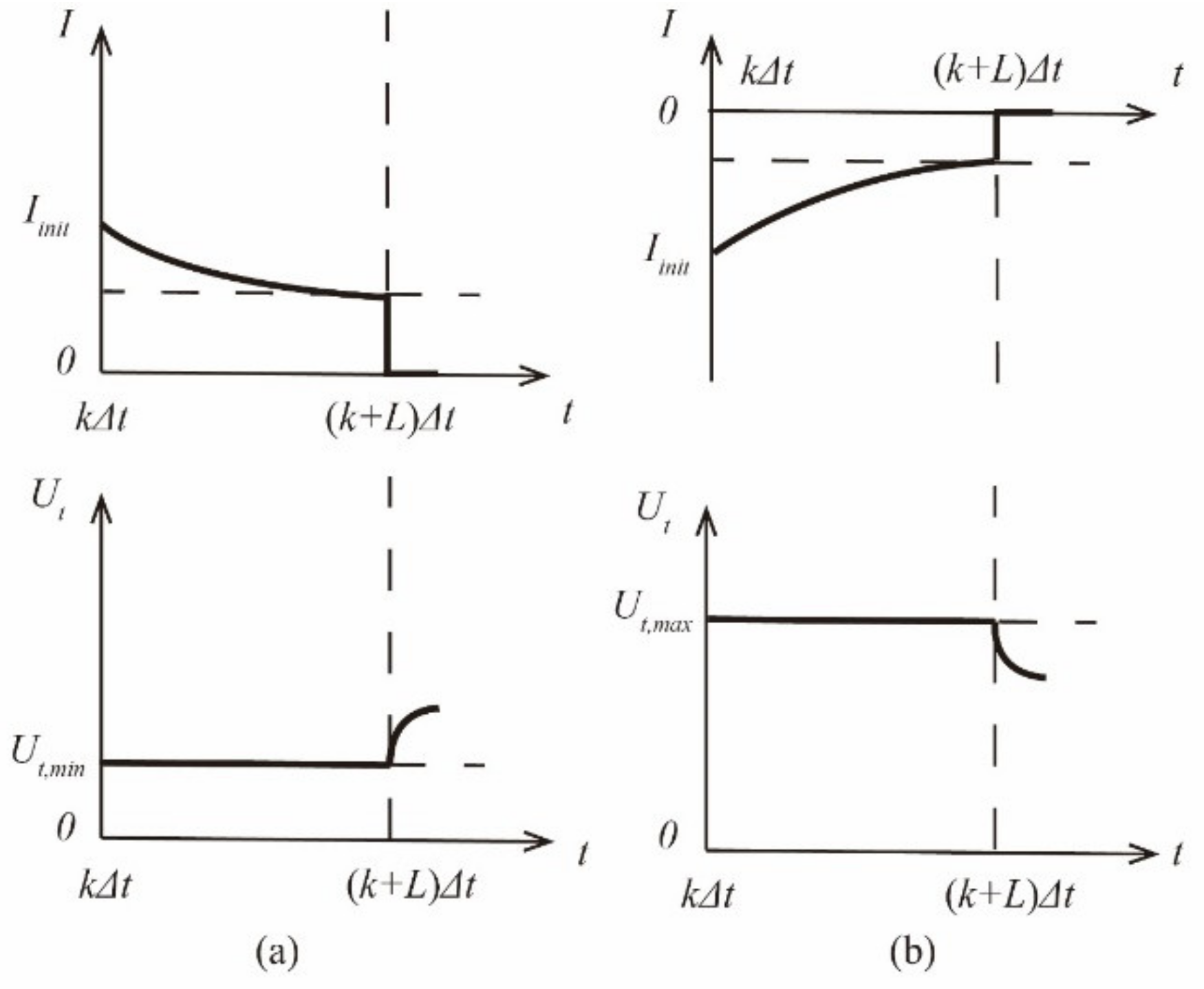
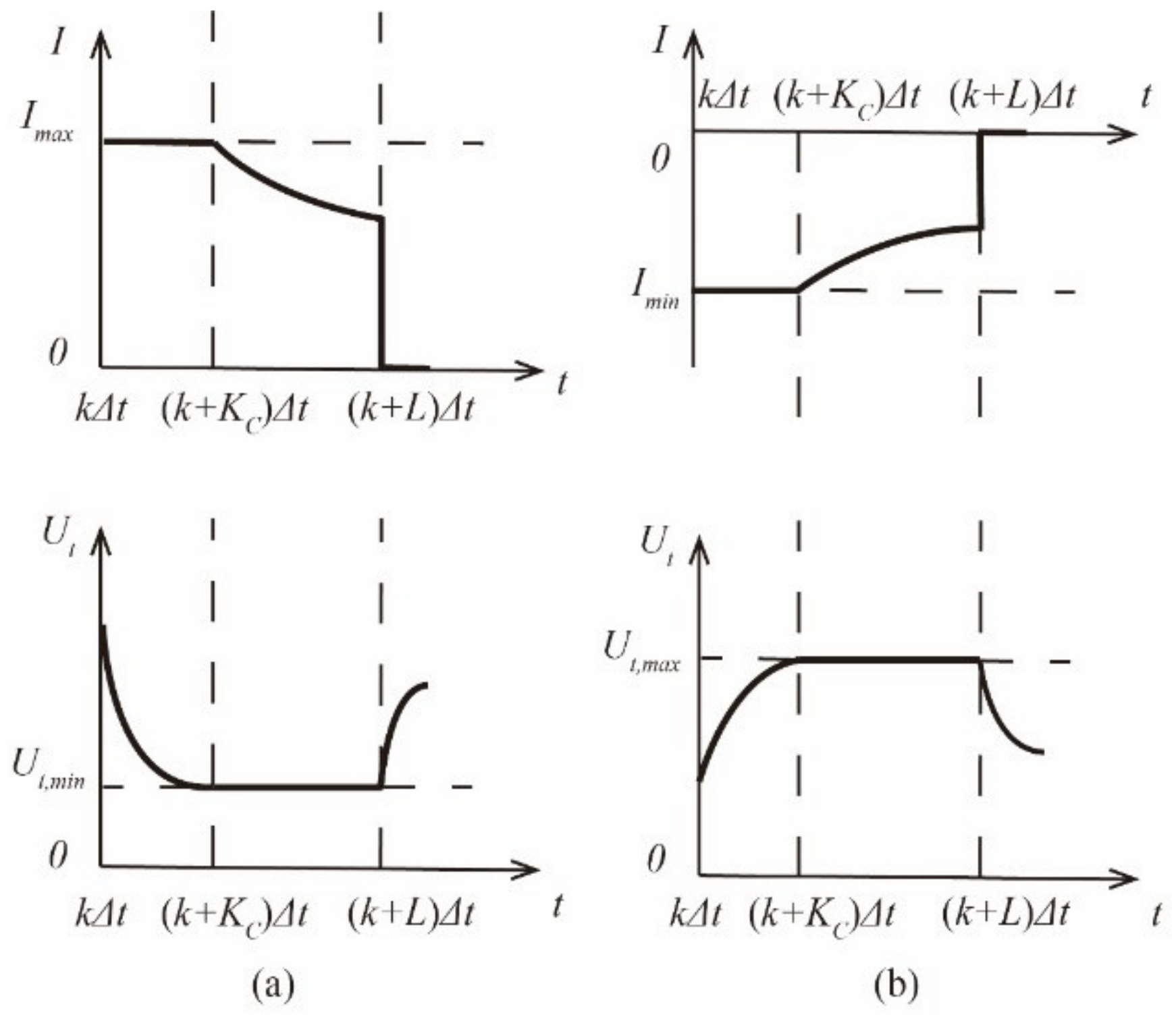
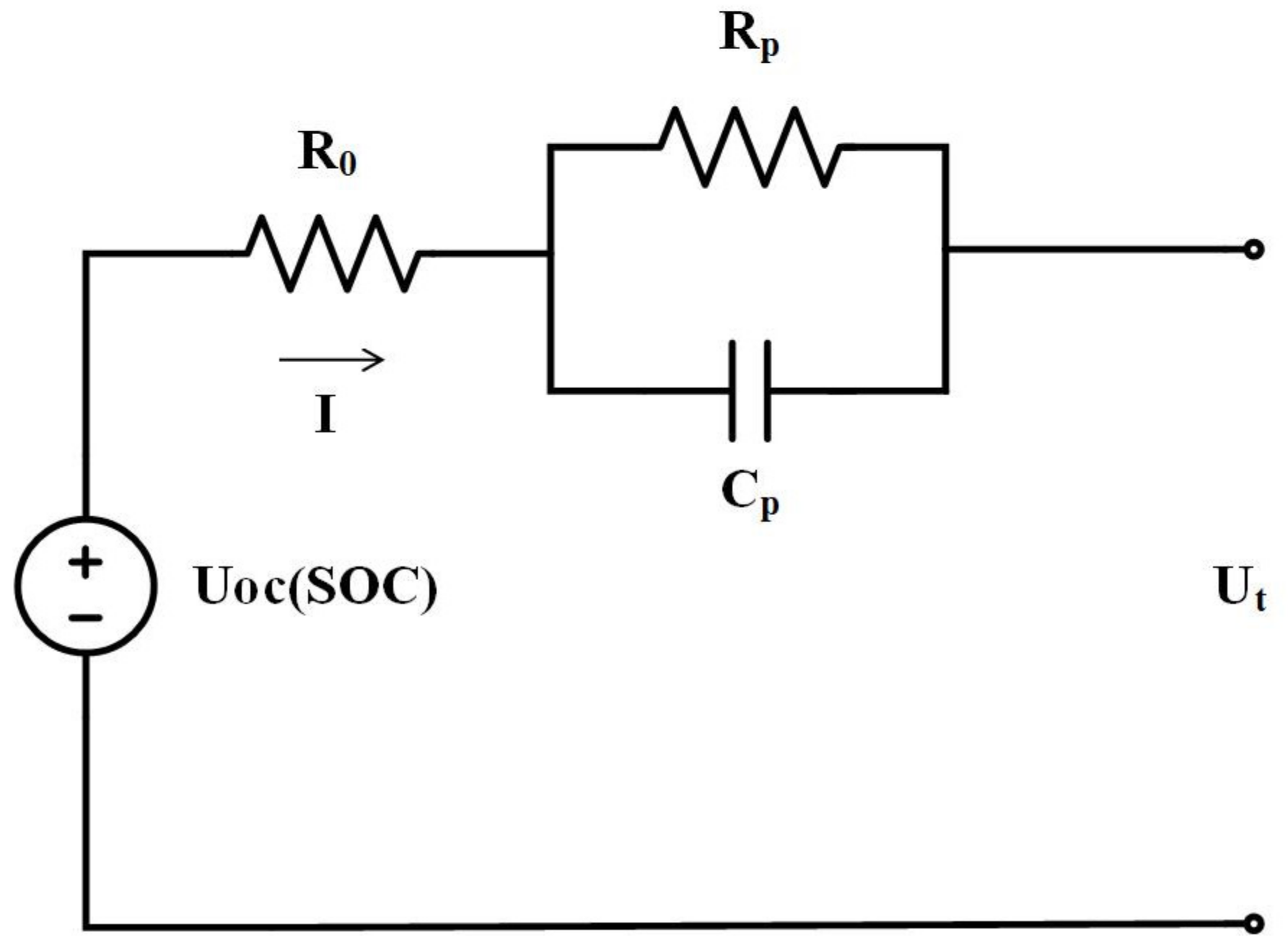
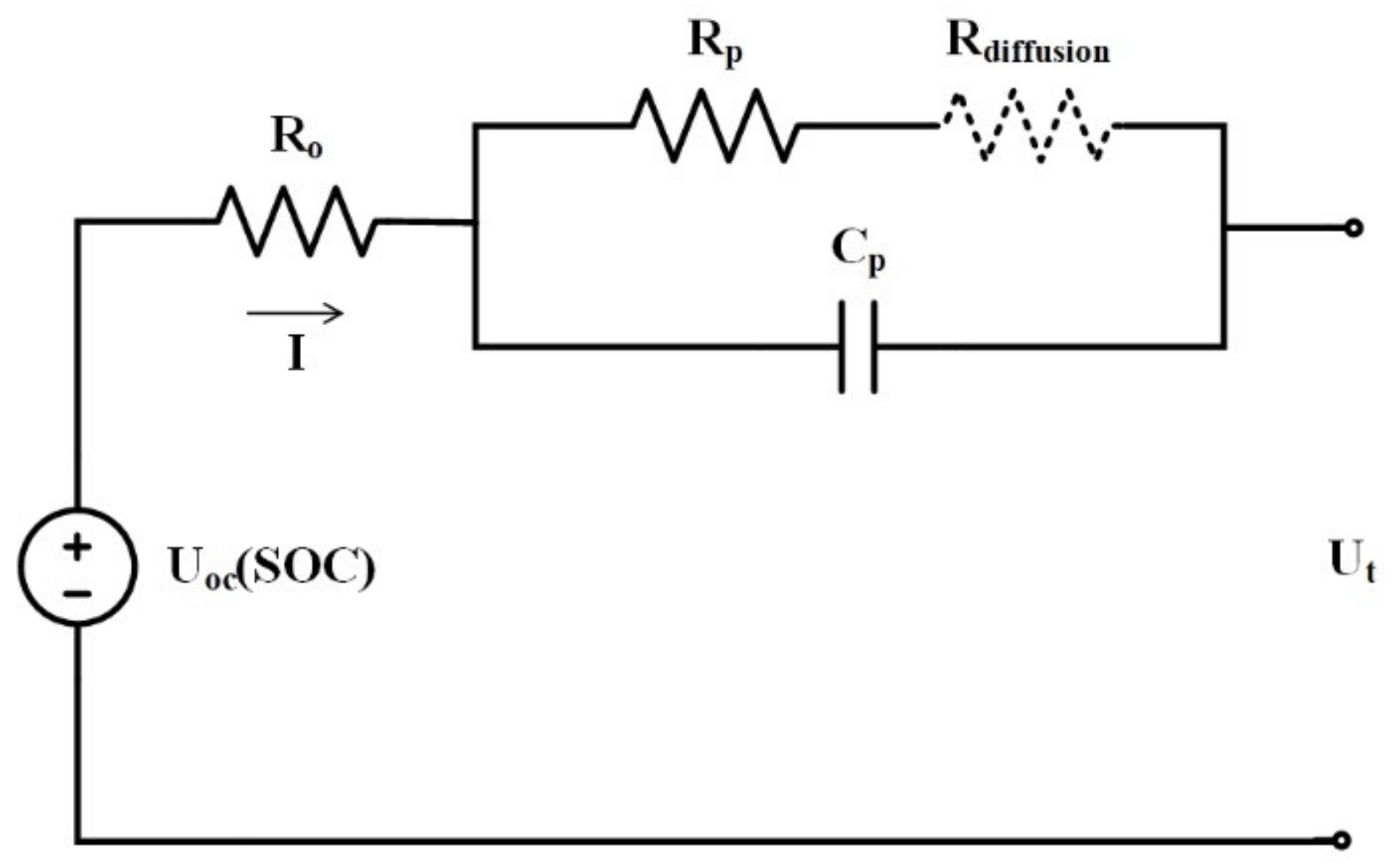
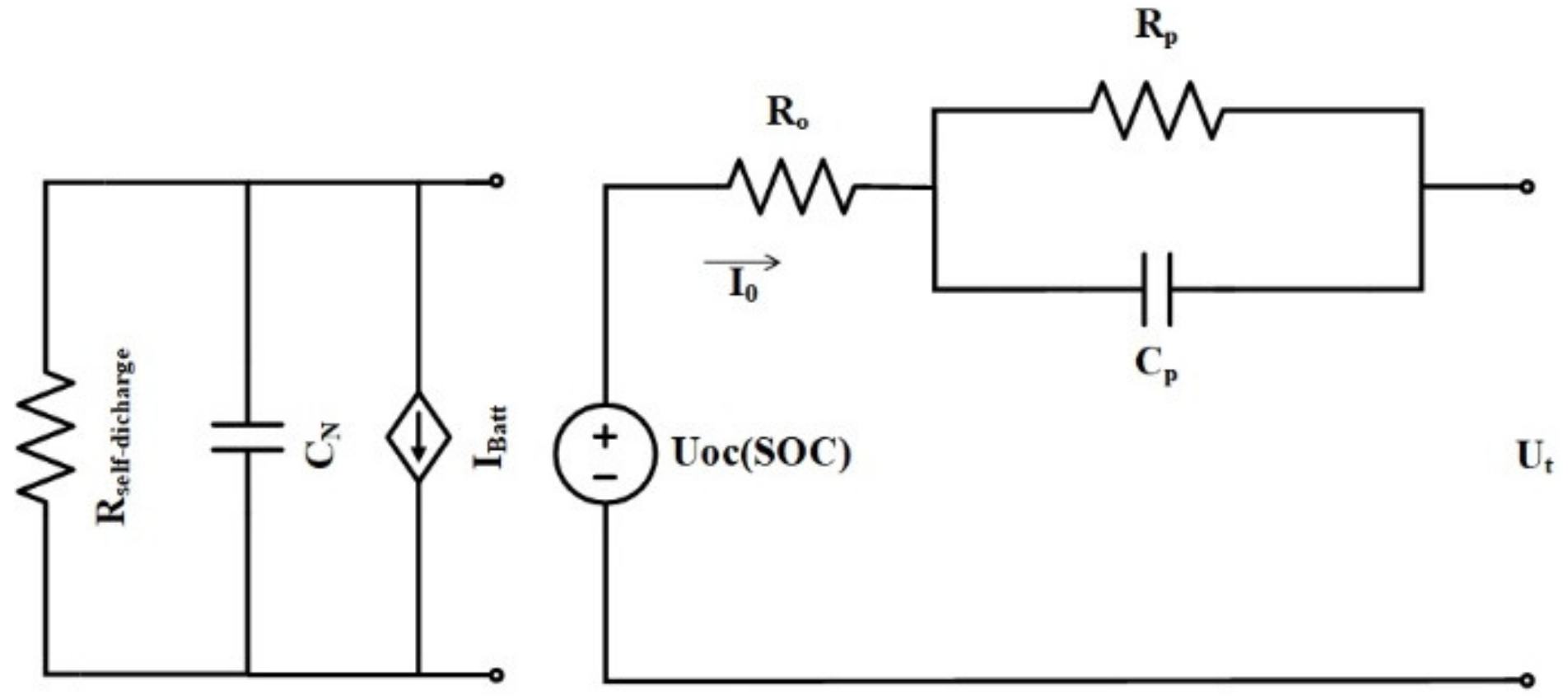
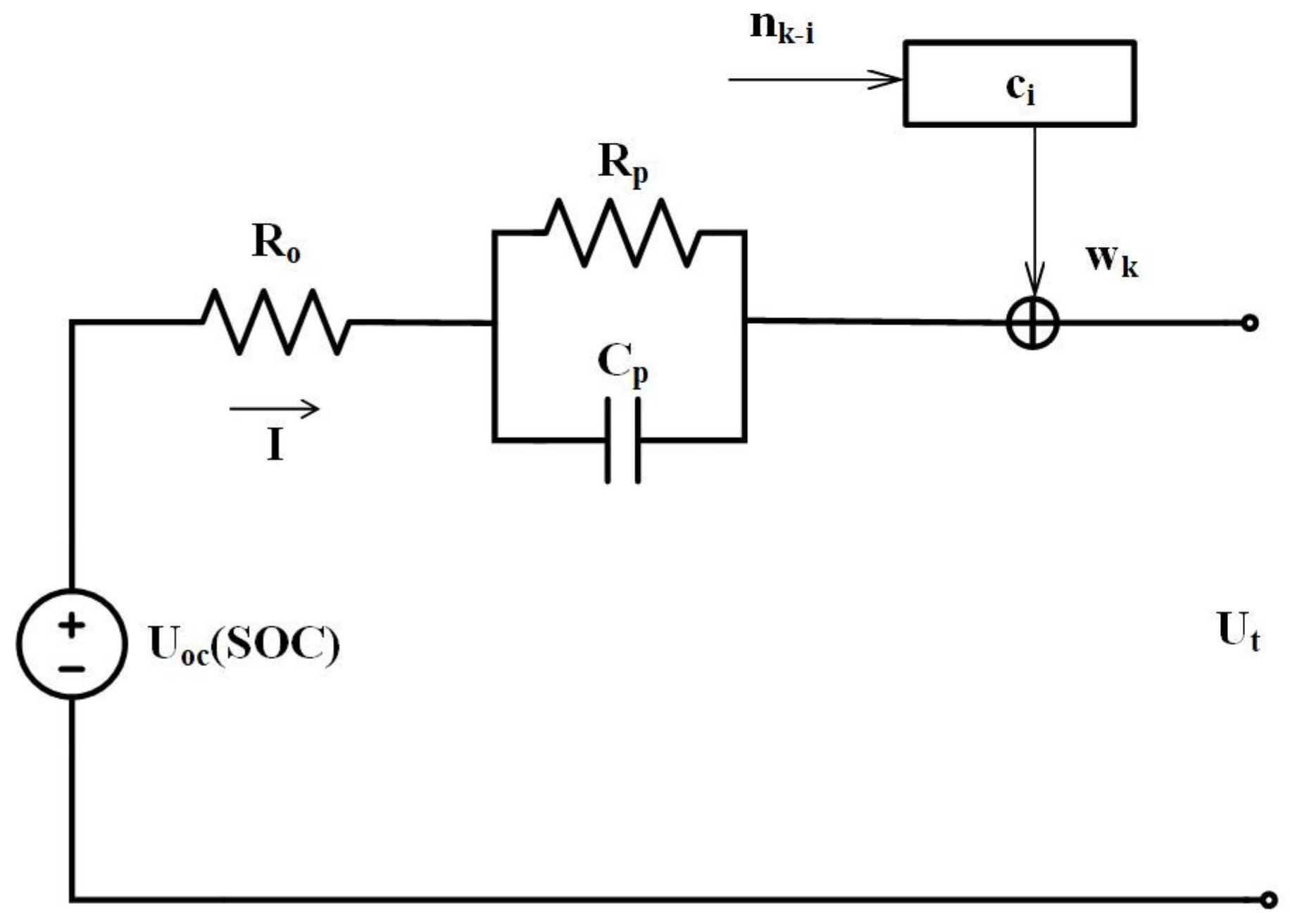
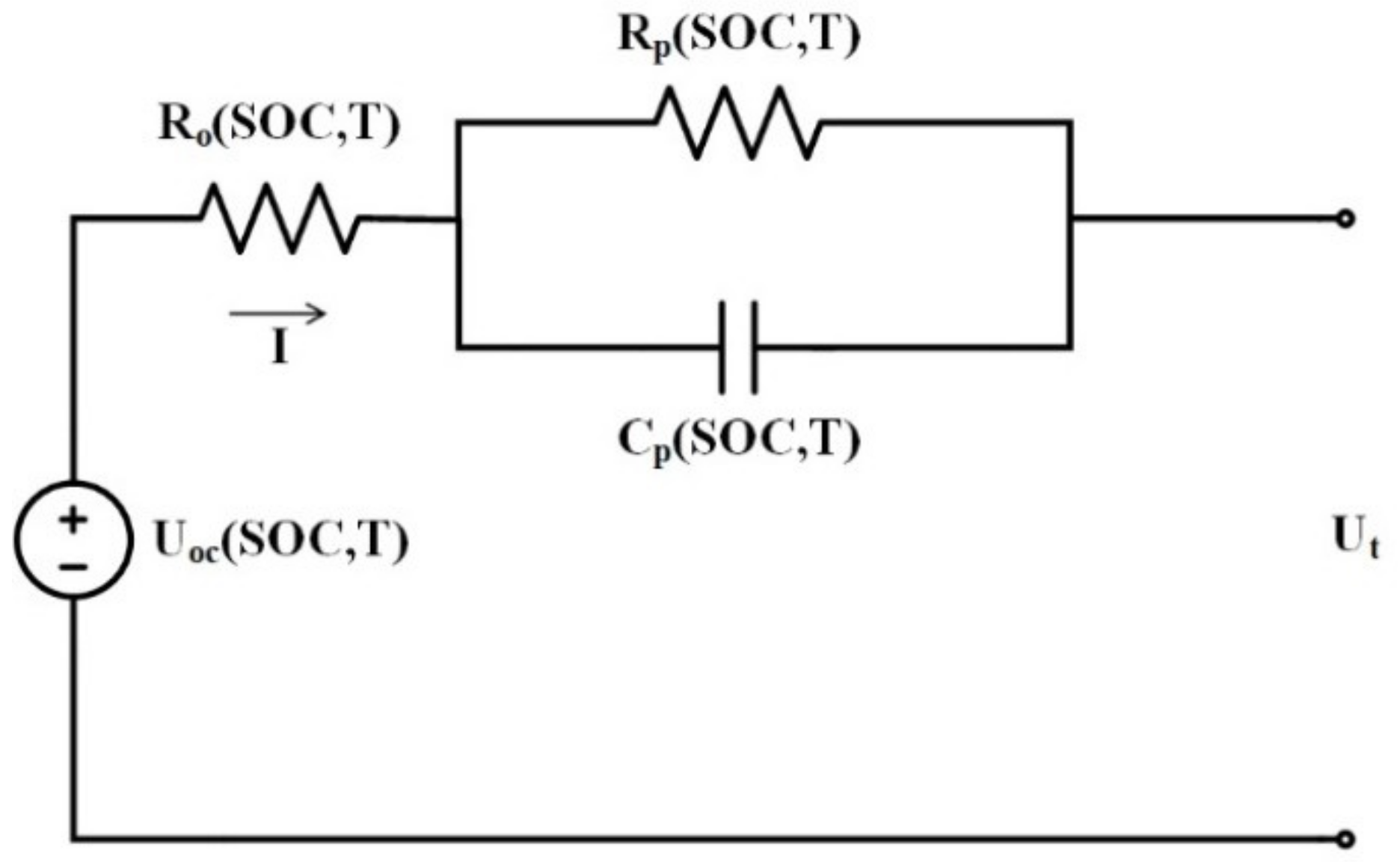
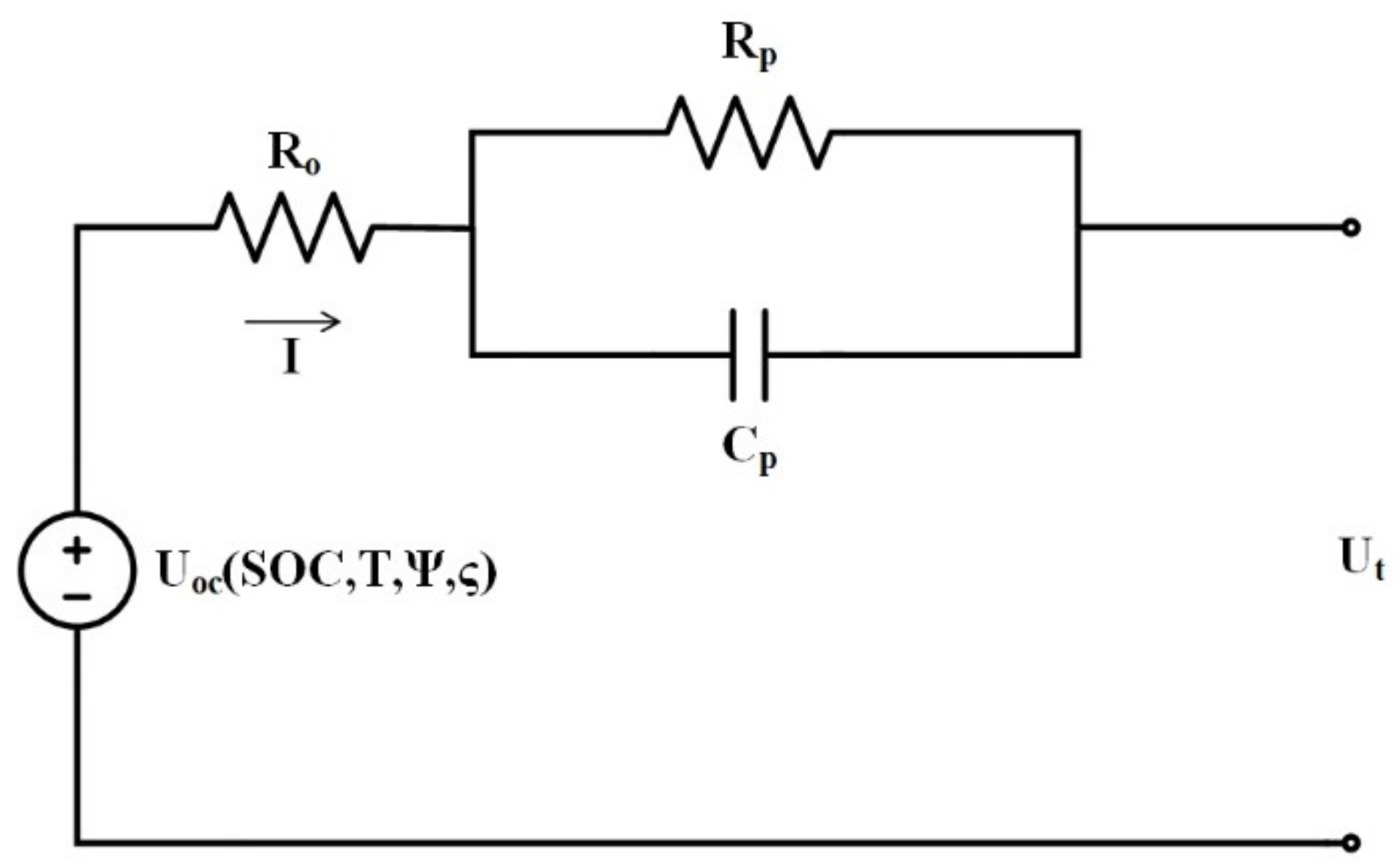
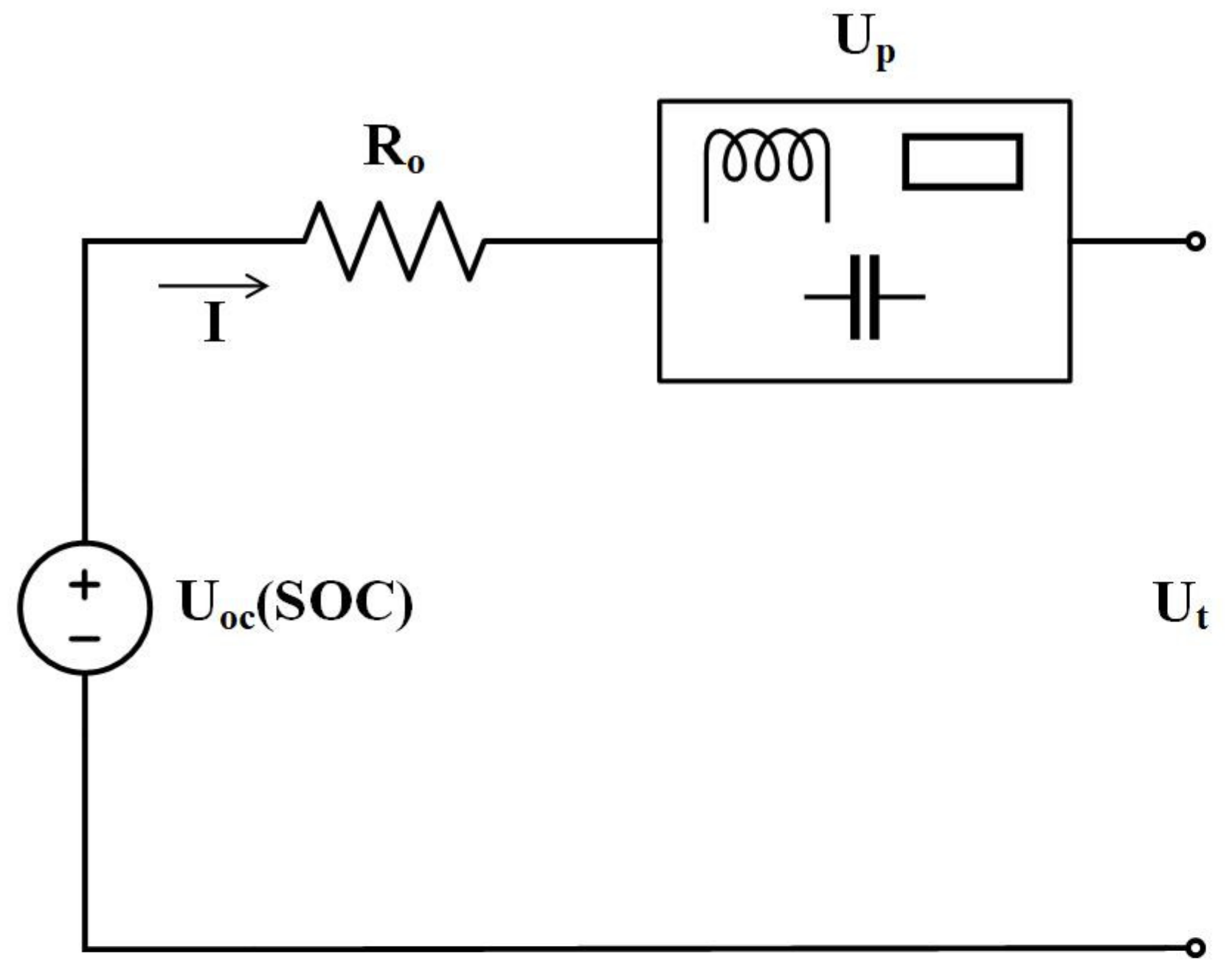
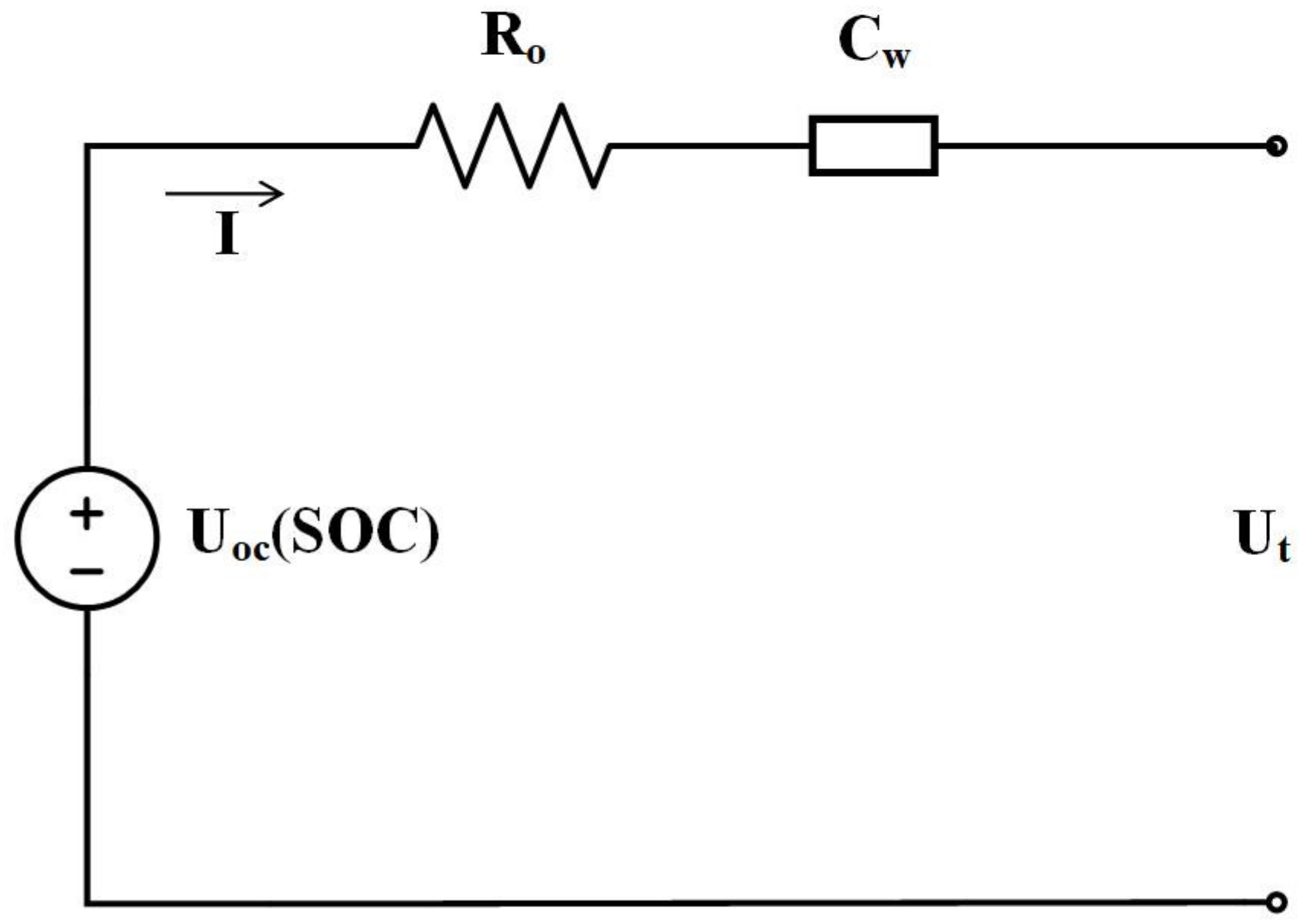
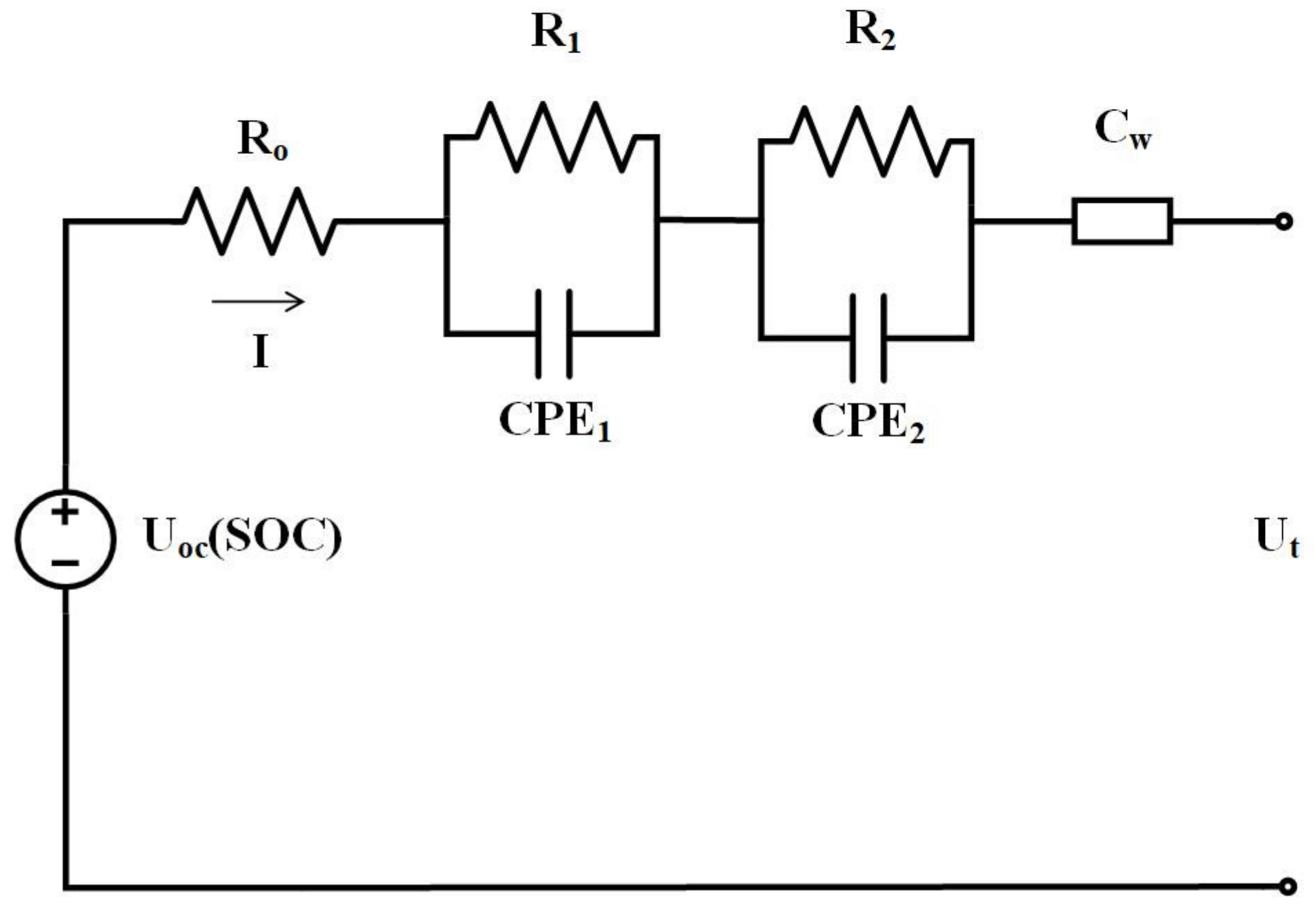

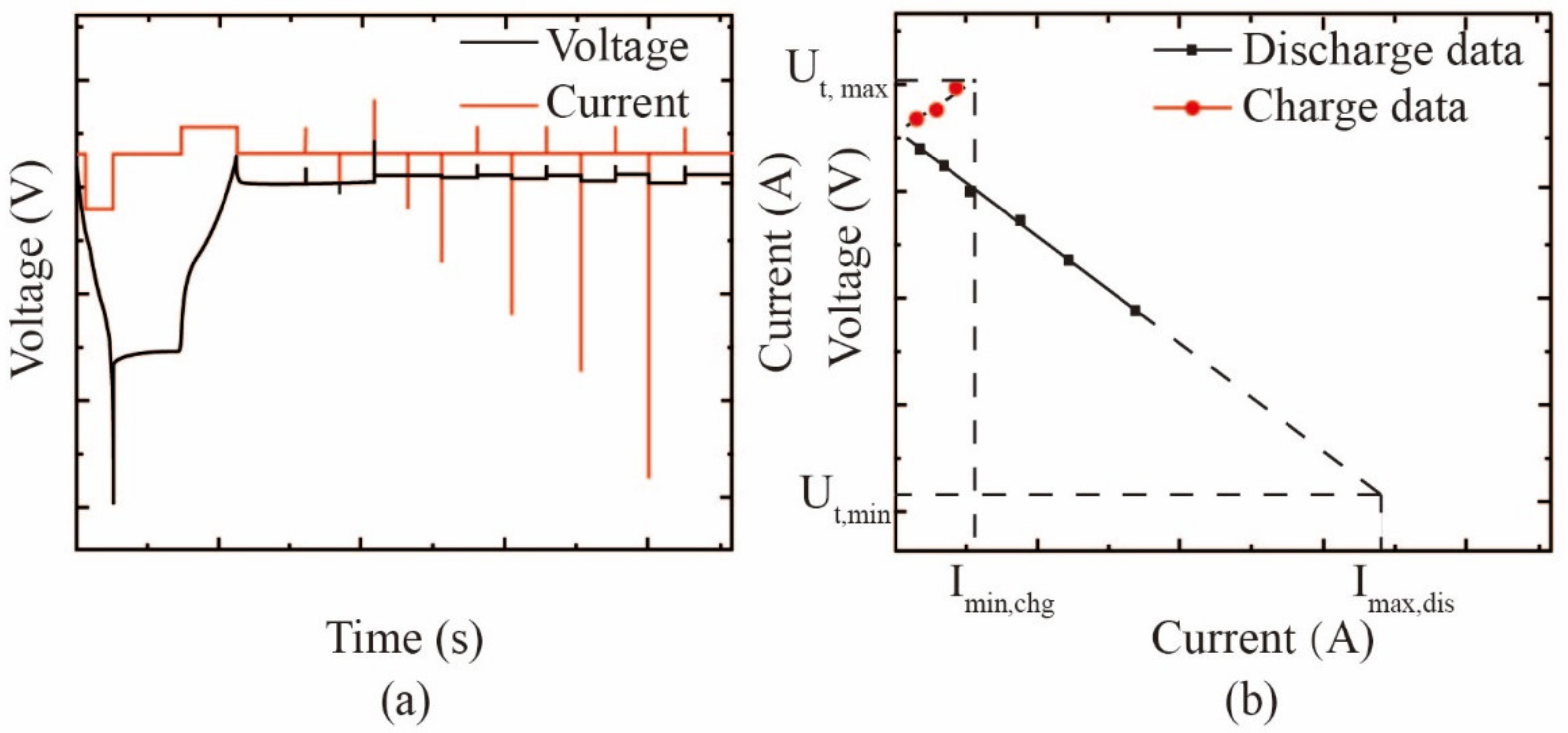
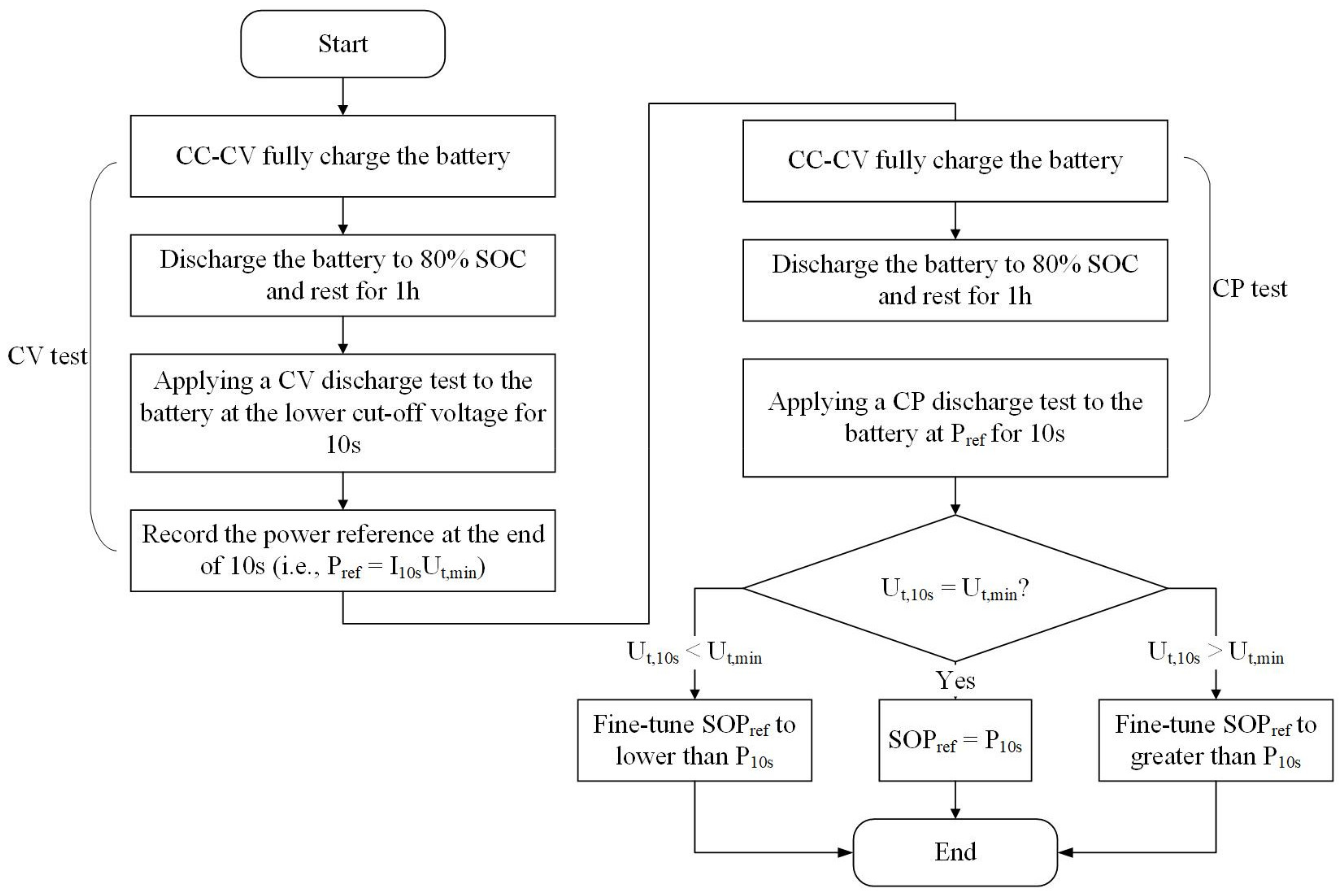

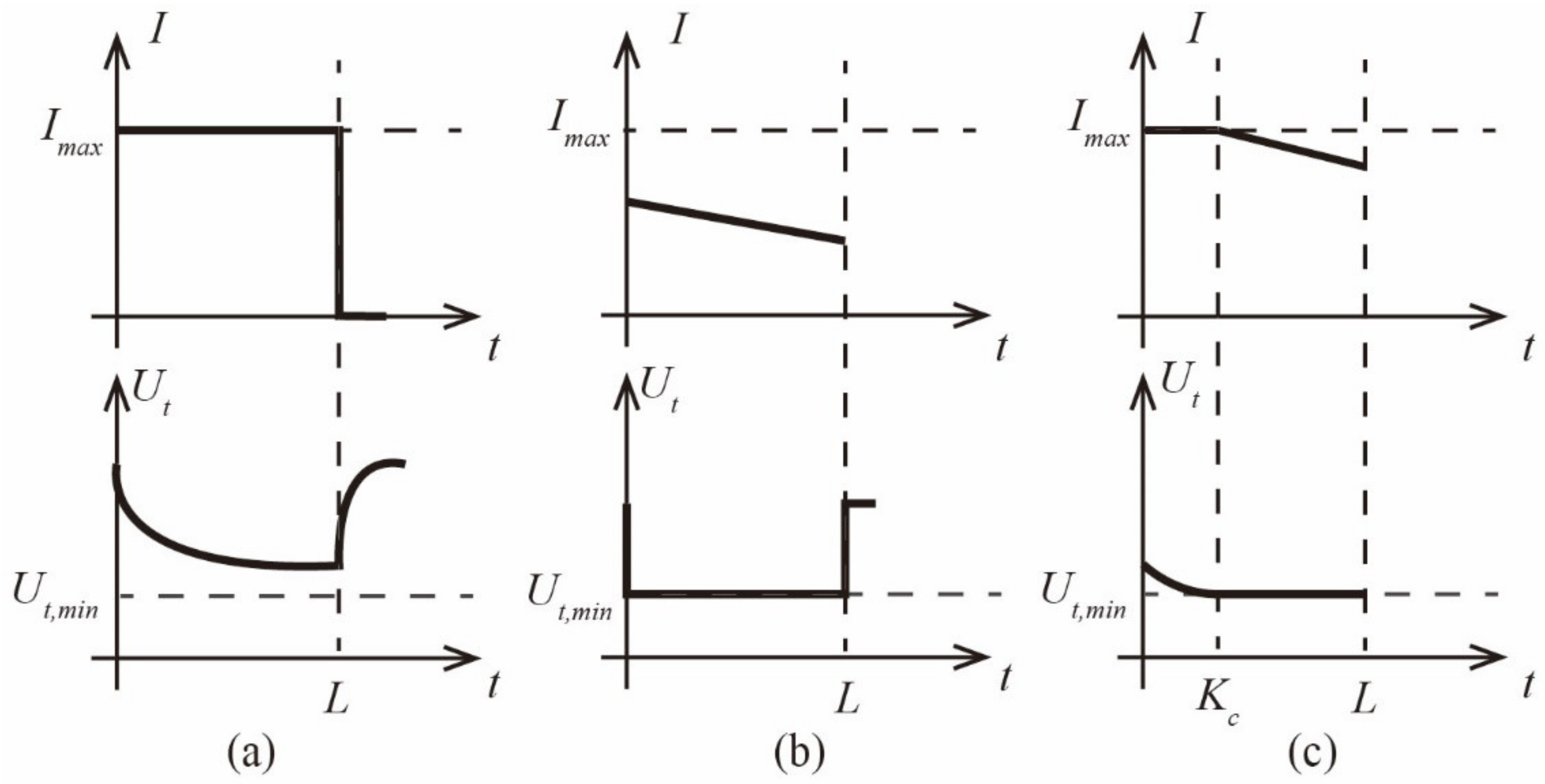
| Improved 1-RC Models | Benefits | Drawbacks | |
|---|---|---|---|
| Structure improvements | 1-RC model with diffusion resistance [19] |
|
|
| 1-RC model with one-state hysteresis [20,21,22,23] |
|
| |
| 1-RC model considering self-discharge phenomenon [24] |
|
| |
| 1-RC model with a moving average noise [25] |
|
| |
| Consider parameter dependencies | 1-RC model incorporating Bulter-Volmer equation [26,27] |
|
|
| Migrated 1-RC model [28] |
|
| |
| 1-RC model with multi-dependent OCV [29] |
|
|
| Other Models | Benefits | Drawbacks |
|---|---|---|
| Multi-dependent Rint model [30,31,32] |
|
|
| Linear regression model [33] |
|
|
| Dual polarisation model [34,35,36,37,38,39] |
|
|
| Simplified fractional-order model [41] |
|
|
| 2-RC fractional-order model with a Warburg element [43] |
|
|
| n-RCW integral- and fractional-order models [44,45] |
|
|
| Research Emphasis | References | Methods | Operating Mode | Special Considerations |
|---|---|---|---|---|
| Long-term SOP estimation | [59] | Optimal searching algorithm | CC mode | Future prediction of R0 |
| [60] | GA | CC mode | Future prediction of R0, Rp and Cp | |
| [61] | Modified VLERO and MMPI methods | CC mode | Future prediction of R0, Rp and Cp | |
| CC mode | ||||
| Optimisation control-based SOP estimation | [62] | DMC | CC mode | |
| [34] | Economic MPC | CC mode | Temperature acts as a constraint | |
| [63] | MPC and fuzzy control | CC mode | ||
| [64] | OLPM and fuzzy control | CCCV mode | ||
| SOP-related multi-state co-estimation | [21,58,65] | OLPM | CC mode | SOE acts as a constraint |
| [8,36,39,67] | OLPM | CC mode | SOC, SOH and SOP estimation | |
| [66] | OLPM | CCCV mode | SOC, SOH and SOP estimation | |
| Machine learning-based SOP estimation | [68] | ANFIS | CC mode | |
| [69] | ELM | CC mode | ||
| Pack-level SOP estimation | [5] | OLPM | CC mode | Parallel-connected battery pack |
| [56] | OLPM | CC mode | Serial-connected battery pack | |
| [70] | OLPM | CC mode | Serial-connected battery pack | |
| [71] | OLPM | CC mode | Serial-connected battery pack |
| Validation Objective | SOP Testing Method | References | Benefits | Drawbacks |
|---|---|---|---|---|
| SOP at CC mode | HPPC test | [11,20,36,66,67] |
|
|
| Hybrid pulse test | [73] |
|
| |
| Constant voltage constant power test | [45,74] |
|
| |
| Constant current test | [43] |
|
| |
| SOP at CV/CCCV mode | Constant voltage test | [13,14,64,66] |
|
|
Publisher’s Note: MDPI stays neutral with regard to jurisdictional claims in published maps and institutional affiliations. |
© 2021 by the authors. Licensee MDPI, Basel, Switzerland. This article is an open access article distributed under the terms and conditions of the Creative Commons Attribution (CC BY) license (https://creativecommons.org/licenses/by/4.0/).
Share and Cite
Guo, R.; Shen, W. A Review of Equivalent Circuit Model Based Online State of Power Estimation for Lithium-Ion Batteries in Electric Vehicles. Vehicles 2022, 4, 1-29. https://doi.org/10.3390/vehicles4010001
Guo R, Shen W. A Review of Equivalent Circuit Model Based Online State of Power Estimation for Lithium-Ion Batteries in Electric Vehicles. Vehicles. 2022; 4(1):1-29. https://doi.org/10.3390/vehicles4010001
Chicago/Turabian StyleGuo, Ruohan, and Weixiang Shen. 2022. "A Review of Equivalent Circuit Model Based Online State of Power Estimation for Lithium-Ion Batteries in Electric Vehicles" Vehicles 4, no. 1: 1-29. https://doi.org/10.3390/vehicles4010001
APA StyleGuo, R., & Shen, W. (2022). A Review of Equivalent Circuit Model Based Online State of Power Estimation for Lithium-Ion Batteries in Electric Vehicles. Vehicles, 4(1), 1-29. https://doi.org/10.3390/vehicles4010001












